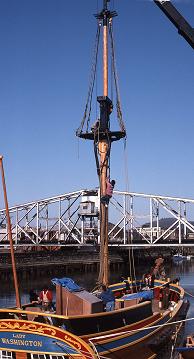Resources for the historian, reseacher, and traditional boat builder

|
The
GHHSA
and its Spar Shop unit believe in maintaining our nation's maritime heritage. Here are some resources for researchers, historians, and serious boat builders who want to learn more about traditional wooden mast-making and spar-making.
|
A bit of mast-making history: How did they do it without a lathe?
|
The Spar Shop builds its masts from a single log. But how did American and European wooden mast-makers create large masts when ancient forests began to disappear? A 1992 National Park Service Report on the
Norfolk Naval Shipyard Mast House
tells the story.
Wooden mast making was not mechanized; the process was labor intensive and required large areas of unobstructed space. Mast making was similar to the process for hewing timbers. Oak and pine were the two species preferred for the masts of naval vessels. Smaller masts were constructed from single trees. Logs were elevated above floor level on a series of wooden blocks. The timber was squared with, and reworked into an octagon shape with an adze. Masts were finished by adze again to level 16 faces. Corners were planed smooth, and plane marks were removed by sanding. As the eighteenth century progressed, scarcities of suitable timber for the single-log construction of large masts led to the development of a new system of mast construction. The system was perfected in the late eighteenth century by English Naval Surveyor, Sir Robert Seppings, as old growth timber from North American sources was less accessible to European markets. European naval engineers were forced to utilize smaller timbers found elsewhere. Under the Seppings system, sections of heart wood in varying lengths were combined. First, the timber was squared leaving rectangular projections known as "coaks." The coaks were carefully cut to fit mortises in the adjoining sections of the mast- Tight joints were critical to the process. Gaps in the mast surface weakened or strained the mast and created conditions for water penetration and wood rot. Once the coaked pieces were joined, the outer surfaces were worked to achieve a circular finished form. Iron rings next were heated and fitted on the mast. A liberal coating of grease was applied to the timber to prevent damage to the wood and to facilitate positioning of the iron bands. The secured heated rings were cooled with cold water to contract the metal which formed a tight band surrounding the wood. The number of iron bands required to secure a mast was proportional to the number of segments in its construction. The larger the number of coaked segments in a spar, the smaller the distance between the rings on the mast. By the late eighteenth century, masts for the English Navy with rings spaced at approximately four foot intervals were recorded. Once the iron rings were cooled, a wood facing was secured to the forward face of the mast to discourage chafing and damage to ship sails. The facing was applied in three sections running the length of the mast. The center section was known as the "front fish" and the side pieces were known as the "fillings." The facing pieces were shaped over the rings to ensure consistent tight joints the length of the mast. Finally, navy masts were usually included between the iron rings, "the wolding...thirteen turns of rope nailed with wolding nails, which had leather washers under their heads." A pre-eminent author on shipbuilding, David Steele, wrote in 1794 that this system "composed of many united pieces of the soundest part of trees...[is] stronger than when made of a single tree, and less liable to spring." These methods of mast construction have remained virtually unchanged into the present day. |
